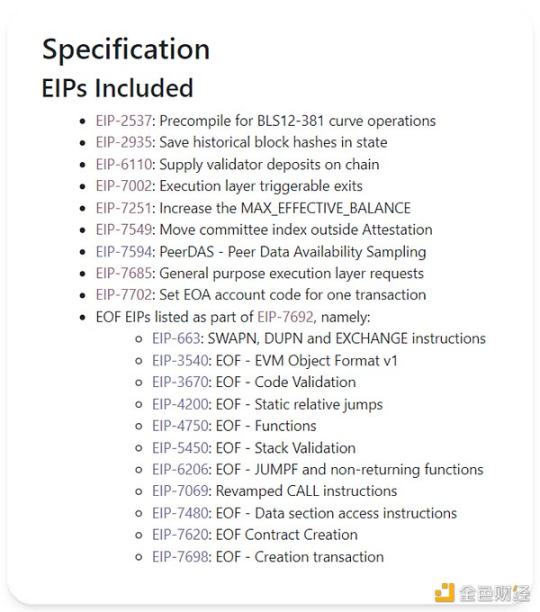Article: William M. Peaster, Bankless
Translation: Deng Tong, Golden Finance
Ethereum has been moving forward.
In March 2024, the network launched the Dencun upgrade. Dencun is a fusion of "Deneb" and "Cancun", aimed at significantly reducing L2 transaction costs.
What's next? Pectra is Ethereum's next major upgrade, which will be more important than Dencun.
Pectra is planned to be launched in the fourth quarter of 2024 or the first quarter of 2025, combining two previously planned upgrades: Prague (for the execution layer) and Electra (for the consensus layer). By merging, Pectra aims to bring multiple ambitious improvements to Ethereum, making it more flexible and optimized than ever before.
What does Pectra include?
Pectra is not just a small upgrade, it is full of updates.
Ethereum Improvement Proposals (EIPs) are proposed modifications to Ethereum. They ensure that network changes are transparently discussed and agreed upon, involving the community and core developers.
For the Pectra upgrade, the current plan is to include 9 standard EIPs and a meta-EIP composed of an additional 11 EIPs.

These EIPs include enhancements to account abstraction, validator operations, and overall network performance. Some of the most notable new features are as follows.
- EIP-2537 — Introduces a precompile for BLS12-381 curve operations, making BLS signature operations faster and cheaper, thereby improving accessibility and performance for Ethereum validators and reducing gas costs.
- EIP-2935 — Implements storing the hash of the previous block in a special storage slot to improve the efficiency and reliability of verifying Ethereum data before stateless execution.
- EIP-7002 — Allows validators to trigger exits and partial withdrawals through their execution layer withdrawal credentials, providing more flexible options for re-staking and staking pools.
- EIP-7251 — Increases the maximum effective balance of Ethereum validators from 32 ETH to 2048 ETH, reducing the required number of validators and simplifying the network's computational load.
- EIP-7594 — Introduces Peer Data Availability Sampling (PeerDAS) to further optimize L2, enhance transaction processing, and scalability.
- EIP-7702 — Adds a new transaction type that allows setting the code of an externally owned account (EOA) during a single transaction, enabling regular wallets to temporarily transform into smart contract wallets to improve user experience.
- EIP-7692 — A meta-EIP composed of 11 EIPs aimed at enhancing the Ethereum Virtual Machine Object Format (EOF) to improve contract deployment and execution efficiency.
A completely improved Ethereum
In the post-Pectra era, Ethereum will meet a wider range of use cases and user needs.
Regular Ethereum accounts will be more programmable, L2 will be more affordable, smart contracts will be more efficient, and validators will manage more flexibly!
With these enhanced features, Ethereum will be better equipped to handle the growing adoption, integrate with other networks, and introduce new features, keeping the platform at the forefront of on-chain innovation.
What happens after Pectra?

Although everything is not yet set in stone, the Ethereum community is paying attention to the implementation of Verkle trees in the Osaka upgrade after Pectra.
"I'm really looking forward to Verkle trees," Vitalik said earlier this year. "They will enable stateless validator clients, allowing staking nodes to run with almost zero disk space and sync almost instantly - a better standalone staking user experience."
That being said, the next upgrade of Ethereum will significantly improve the chain's usability for users and developers. Ethereum cannot be built in a day, but steady progress is the key to building everything the network is aiming for in the future.
免责声明:本文章仅代表作者个人观点,不代表本平台的立场和观点。本文章仅供信息分享,不构成对任何人的任何投资建议。用户与作者之间的任何争议,与本平台无关。如网页中刊载的文章或图片涉及侵权,请提供相关的权利证明和身份证明发送邮件到support@aicoin.com,本平台相关工作人员将会进行核查。




